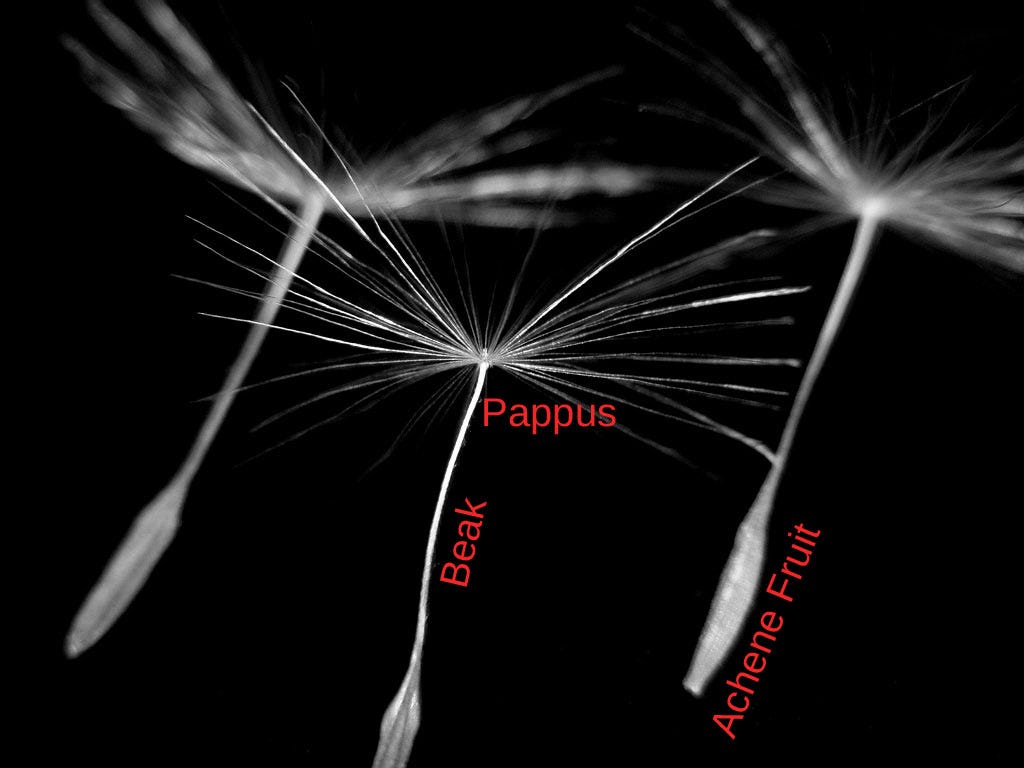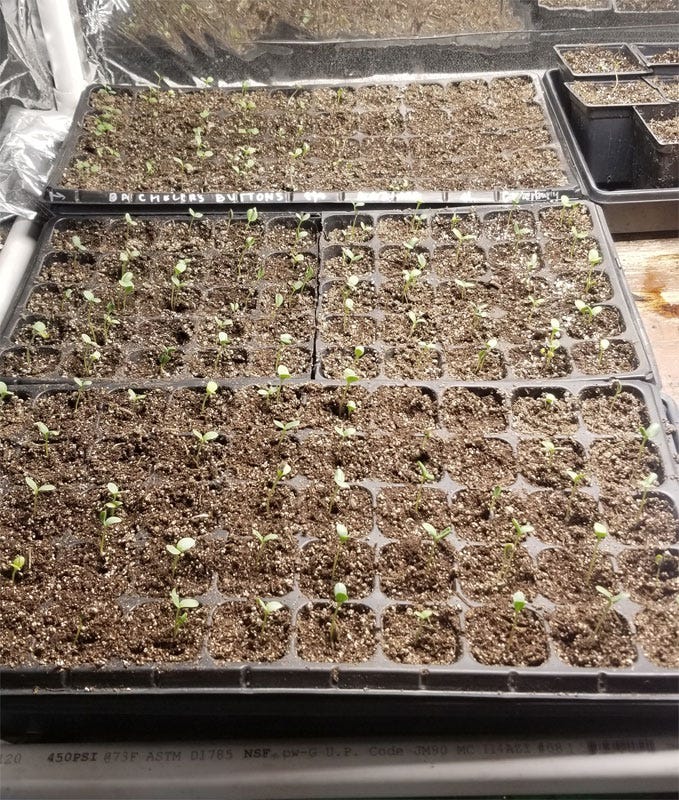It’s one week closer to garden time in the norther hemisphere and I’m ready for it! I have so much hope at this time of year. One of the first wildflowers you’re likely to see in early spring is the venerable Dandelion. The French know this flower as “dent-de-lion” or lion’s tooth. The name didn’t make sense to me at first but only because I mostly see yellow florets in my area. There are white dandelion florets but I think lion’s tooth refers to the petal's shape. I still prefer the French name. In England, the dandelion is known as a “wet-a-bed” due to its diuretic properties so that’s a useful fact... Many pollinators depend on these early emerging flowers after a long winter so please let them grow. Dandelions are ruderals which means they are one of the first plants to grow in disturbed soil. It’s almost as if nature prefers to have plants growing in the soil instead of leaving it bare. Read some of my other posts for more on why this might be. Some of you already know how amazing this flower is. Some of you might hate this flower. If that describes you I’m going to give you a few reasons to appreciate the lion’s tooth.
What is a dandelion clock? After a dandelion flower blooms it closes up and the petals dry up and fall off before the beautiful puffball emerges. This puffball is known as a dandelion clock. I know it doesn’t look like any clock you’ve ever seen but it is a type of clock. Some children and even a few adults know the secret of dandelion clocks but only the lucky ones. If I tell you the secret you must promise to pass it on to as many people as possible. Better yet, show them how to use a dandelion clock. To tell the time with a dandelion clock you hold it close to your lips and blow hard. If you blow most of the ball away it is 1 o’clock. If it takes two blows then it is 2 o’clock and so on. Now you know. A word of caution is prudent here. I would suggest using an abundance of caution when utilizing this method of telling time near Lawnies (lawn-loving folk). They might chase you down.
Did you know dandelions close up at night? Didn’t your Mother tell you “nothing good happens when you’re out past the dandelions”? Or was it, “be home before the dandelions open”? I can never remember. Of course, she reads Wild Asparagus so maybe she’ll refresh my memory. Did you know that milky substance when you break the stem of a dandelion is latex rubber? Latex exists in the roots as well which repels some insects. The Russian dandelion is an ideal candidate for industrial latex production. Millions have been spent testing rubber from dandelions in car tires. About 10-30% of a car tire is natural rubber. Using dandelions with short growing cycles might be better than using rubber trees which take a lot longer to grow. Continental tested prototype tires in 2014 but I don’t think the tires are ready for prime time quite yet. Neat!
Now let’s move on to the most amazing thing about dandelions and how they can improve your life. Everyone knows when you blow on a dandelion clock little seed umbrellas called pappus float forever on the breeze, more than a mile even. When the seed fruit breaks away from the pappus and falls to the soil the cycle of life continues. This of course isn’t a revelation to most humans who have been outside. In 2018 researchers at the University of Edinburgh discovered how these little umbrellas seem to float on forever. As usual, the closer we look at seemingly simple things in nature the more we appreciate the complexity of God’s design and how perfectly His system works. Some might prefer to use the term evolution rather than design but no matter your explanation of how these things came to be we can all sit together and appreciate the magnificence of dandelion flight mechanics.
So what did they discover? A dandelion pappus features about 100 filaments above the achene and beak. When the wind lifts the dandelion pappus into the air these filaments slow the descent which allows it to travel long distances. You might assume that the large surface area and low weight of the pappus are responsible for the extended flight time. They play a role but the researchers found out there was much more going on. The fibers atop the pappus only make up about 10% of the surface area as compared to a solid disk of the same diameter! And yet the pappus filaments produce four times as much drag as a solid disc of the same diameter would. Imagine if your removed 90% of the surface area from a parachute and jumped from an airplane-how well would that work? If I said that same parachute would slow the descent of four humans with 90% of the material removed that would be crazy! Here is a video that will allow you to visualize what the researchers found.
What if I told you the pappus slows descent by generating lift? That’s what’s happening. The secret is in the perfectly arranged spacing of the pappus filaments. As the pappus falls the individual streams of air travel upward through the filaments in a very precise way that creates a low-pressure vortex ring similar to a smoke ring. This separated vortex ring is constantly swirling as the pappus falls. This circulating ring generates lift as long as there is wind to pick up the pappus in the first place. Without the space in between the fibers, the floating pappus can’t float nearly as far. It isn’t the fibers as much as it is the specific spacing in between the fibers that allow for such perfection. What can we learn from this miracle of God’s design? A lot!
Sometimes we’re so focused on the next crisis or the next vacation that we fail to appreciate the space in between. Perhaps focusing more on the space in between is a worthy endeavor. The phrase “economy of happiness” instantly jumps to the front of my mind as I write this. I’ve written before about how force isn't the best way to accomplish most goals. The pursuit of happiness should be a graceful proposition. Have you ever been on a vacation or to a family reunion where it’s so structured and forced that it cancels joy? The way of the dandelion clock teaches us that it’s ok for time to be subjective once in a while and that paying attention to the space in between has the potential to gracefully lift our spirits on even the lightest breeze.
As I learned more about the mighty lion’s tooth I was given another witness that forces are acting in close proximity to our spirits which are invisible to our mortal eyes and yet they have the potential to lift us. The low-pressure vortex ring acting above the pappus is separated from the pappus and yet it still provides lift. Without technology that vortex would be impossible to see. Without visual evidence of the low-pressure vortex acting, we would have to rely on assumptions about how and why the dandelion pappus does what it does. Only a few years ago we thought we understood what was going on. We can’t see spiritual things. Does that mean spiritual forces aren’t acting in our lives? I think this question is worth thinking about.
All things are created spiritually before they take physical form. There is an eternal magnetism of unimaginable power holding the physical and spiritual world together. Have you experienced this? Someday I believe we will have detailed explanations of everything we question and face in mortality. I hope that showing you previously unknown and unseen physical things will give you faith that the answers to mysteries of the spirit exist even if we don’t have access to the full explanation yet. I believe God has given us natural things to act as metaphors that can help us understand some spiritual truths. If you want to know if something is true I would encourage you to ask Him directly.
OK, some of you were just here to learn about flowers right? We live amongst miracles and beauty. Let’s enjoy it together. So I started a few hundred plants. Would you like to see them? I’ve added descriptions to each image so you get an idea of what’s growing. Thanks for reading. May you always have a living root in your soil.
Adam

















Great article Adam.
I loved so many of your thoughts and feelings along with learning things that are tiny miracles.
One of my favorite childhood things to do was to pick dandelions with my friends and we would hold them under each other’s chins to see if they reflected the color yellow If they did it meant you liked butter.
Lovely and interesting insights but I still don’t appreciate then in my yard. Have you tried them in a salad?